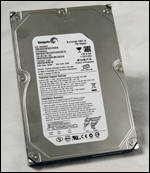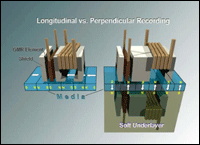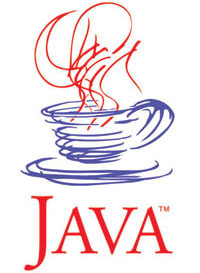
Over the past several years, hard drive capacities have ratcheted up, but the increases have been incremental. Recent 500GB drives, including Seagate's own Barracuda 7200.9, have been four-platter designs. Typical platter capacities for most recent-generation hard drives have ranged from 125 to 133 GB per platter, only up a bit from the previous 100GB per platter.
Now, Seagate is shipping its 7200.10 series, including a suite of products that differ only in the amount of buffer available or in the disk interface. SATA 3Gbps drives include the ST3750640AS, offering a 16MB cache, while the ST3750840AS ships with 8MB. Also available are the ST3750640A and ST3750840A, which are the 16MB and 8MB parallel ATA versions, respectively. Other models are available in lesser capacities, including 500, 400, 320, 300, 250 and 200GB models. Platter densities may vary somewhat, with the flagship 750GB drives packing In 187.5GB per platter, while the 200GB drive is a single-platter design.

Seagate's 7200.10 is the first desktop hard drive to use perpendicular recording technology, though the company previously shipped the 160GB Momentus 5400.3 2.5-inch hard drive for laptop and mobile users.
The tiny magnetic domains on platter surfaces orient themselves one direction to represent a binary 0, and another direction to denote binary 1. In the past, these domains' orientations have existed along the planar surface of the platter. Perpendicular recording takes the orientation vertical, allowing the drive to pack more bits onto a platter.

Perpendicular recording enables 200GB drives using a single platter, and a 750GB drive using only four platters. Since these really represent the first generation of desktop drives using the new technology, it's likely that platter capacities will increase as the drive companies gain more experience with the technology. Of course, perpendicular recording is just another step along the capacity road. Seagate has already announced it's working on a technology dubbed "HAMR" (heat-assisted magnetic recording). HAMR may allow density increases up to 100x, which means areal densities of 50 terabits per square inch.
But even if HAMR technology can be used to build products, it's unlikely we'll see anything before 2010. So purely magnetic solutions, like perpendicular recording, will fill the void until then.
Price: $500 check prices
Pros: Huge capacity; fast; quiet operation; good cost per gigabyte.
Cons: Runs a little warm; backing up full drives can be problematic.
Summary: Seagate delivers a winner, using perpendicular recording technology to deliver record capacities per platter and excellent transfer rates at a reasonable price.

